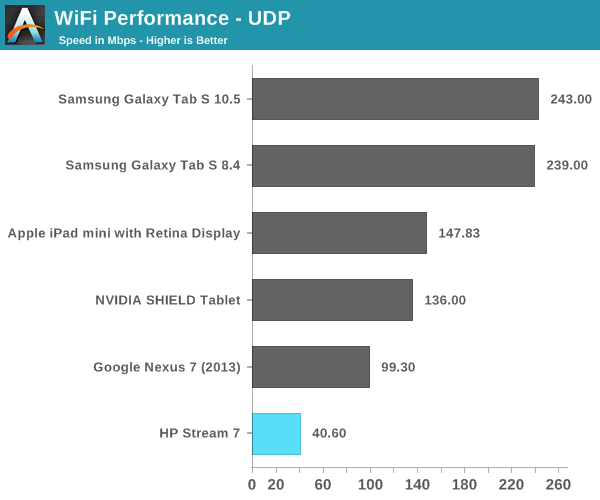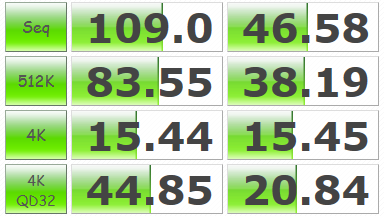HP Stream 7 Review: A $119 Windows Tablet
by Brandon Chester on December 19, 2014 8:00 AM ESTCamera
It looks like including a camera is now a requirement for pretty much any device, and so even the Stream 7 has a front-facing and a rear-facing camera. In the Windows device manager, the front camera identifies itself as "Camera Sensor GC310". I haven't been able to find any information about it, but the image quality leads me to believe that it may be best for people to not know where it came from. The rear camera idenitifes itself as HM2056, which I was able to find information about. It's made by a company called Himax Imaging, and if you haven't heard of them it's okay, because I hadn't either. It's a 2MP 1/5" sensor, which translates to 1.75 micron pixels. It has no auto focus, and that combined with the specifications leads me to believe that this is normally intended to be a front-facing sensor.
As you can see, the output is really bad. The text on the back of the books is illegible, most detail is lost, and there's noise everywhere. It's just honestly not a good camera, and it's something I would only use as a last resort. It's somewhat annoying that HP felt the need to even put a rear camera on the Stream 7, as it adds to the BOM and the money could have been better used on something like a larger battery.
NAND
I mentioned earlier that the Stream 7 doesn't even have enough storage to fit PCMark 8 and some of the other benchmarks we use. Out of the box, you get around 18.5GB free. This means that we can't run our typical Windows storage benchmarks, so I've used CrystalDiskMark to get an idea of how the storage performs.
I wouldn't try making direct comparisons between this and our storage benchmarks on Android and iOS, but it's still able to give you an idea of what you can expect. The Stream 7 uses Samsung's MGB4GC eMMC solution, so we can't expect the same storage performance that you get from Windows devices with a full blown SSD. The read and write performance ends up being pretty good for an eMMC solution, although I'm suspicious of the 4k random write result considering how even the best eMMC solutions we've seen in Android and iOS tablets top out around 3MB/s.
WiFi
The HP Stream 7 uses a Realtek RTL8723BS solution for WiFi and Bluetooth. This is a single spatial stream 802.11n part, with no 5GHz support and only 20MHz channel width. That means that we're dealing with a theoretical maximum speed of 72Mbps. In real world use, it's quite a bit less, as you can see below.

Again, at $119 this is expected and can be excused. Faster WiFi would be nicer, but it's not free. My only complaint about this speed in the real world is that the slow WiFi makes it difficult to move large files over the network onto the Stream 7. This wouldn't be an issue if these Windows tablets allowed you to directly move files to them from another computer over USB, but they don't. I've also encountered issues with the WiFi disconnecting intermittently, which is incredibly frustrating when it means you have to begin transferring a large video from the beginning. I've contacted HP about this to see if they're aware of this issue, as I've seen complaints about it from other users, but I haven't received a response.
Misc
I am unfortunately not equipped to do objective audio testing on the Stream 7. It uses Realtek's audio codec, and so it isn't likely to be anything exceptional. The bottom mono speaker is adequate; there's not much to be said about it. Unfortunately, everything comes crashing down when you try to use the 3.5mm jack. Even if the Stream 7 had the best audio solution in the world, it would be crippled by this defect that I cannot believe made it to production.
Essentially, the 3.5mm jack has a great deal of noise and static, and it makes it effectively unusable. I have confirmed this with two other owners, and there are complaints about it on the web. It's likely that there's an insufficient amount of shielding for the audio port and PCB connections, and it's extremely disappointing. With its support for all the great video players on Windows, the Stream 7 could have been an inexpensive and powerful video player. But unless you're going to use the built-in speaker or Bluetooth headphones/speakers, there's no way to listen to audio on this tablet. When I reached out to HP about the WiFi connection issues I also asked about this, but again I haven't received a response.


















157 Comments
View All Comments
beggerking@yahoo.com - Monday, December 22, 2014 - link
you can't run flash or FULL APPLICATIONS on your Android nor icrap.this is a FULL LAPTOP on tablet form for $100.
beggerking@yahoo.com - Monday, December 22, 2014 - link
and i have Toshiba Encore II 8 which is a similar device with only 1gb ram.it runs faster than my ipad mini retina on everything and i was able to open 8-10 browsers without leg.
ados_cz - Monday, December 22, 2014 - link
Cannot agree more, very usable in deed. I have faster eMMC on Linx 7, 170 / 65 MB/s and hard-set swap file to 2GB, have not run into any problem so far.tipoo - Friday, December 19, 2014 - link
Try a tablet with 1GB RAM on Windows before talking about it, for tablet uses like mail, the browser, etc, 1GB is decent so long as you stay in Metro. This isn't for loading desktop apps on.mss2 - Friday, December 19, 2014 - link
Though even there, it depends on the desktop app. I bought one to replace the 10-year-old iPod we use to play music in the kitchen, so we run desktop iTunes (there being no Metro version, Apple presumably not being in a hurry to support a competing tablet). Fortunately, either we don't have the headphone jack issue reported here, or it's not noticeable at relatively low volumes on a dock that's not exactly audiophile-quality itself.It's easily the cheapest device that would a) hold all our music, with a microSD card, and b) support the star ratings and playlists we've already got in iTunes. (Any iDevice would be at least twice as much. I use various Android sync tools on my phone, but they don't Just Work without any issues. Mirroring the music directory from my desktop does.)
I'm not a huge fan of the onscreen keyboard (true on my Surface Pro as well; I wish Microsoft would let Swiftkey or someone take a crack at it). But for setup, I had an old folding Bluetooth keyboard first used with a Windows Mobile PDA a decade ago that still worked. Since then, it's worked fine as a music player with a sideline in light web browsing. Overall, I'm genuinely impressed at what a $99 device proves to be capable of.
tipoo - Sunday, December 21, 2014 - link
Fair point, some simpler desktop apps will also work. And also good point for a use case, streaming audio would work well on this, if the headphone jack issue was indeed just a manufacturing error and not within spec and not common.Did you try the headphone jack on actual headphones by the way? Is it noticable there?
tipoo - Friday, December 19, 2014 - link
I beg to differ, the niche, sometimes low end devices that you call "boring" are a refreshing change for me, most people aren't buying high end all the time. I was also interested in the Streams specifically as gifts for people who don't need many apps, just a Metro browser basically.eanazag - Friday, December 19, 2014 - link
I also am interested in this review. Not totally sold on the device, but the price is great. A sub $100 device does make me nervous. There are goofy things that you may want a Windows device for in the single task category. This is clearly not a do everything device.What size SD card does it support up to?
Brandon Chester - Friday, December 19, 2014 - link
I have seen it listed as "Up To 32 GB of Expandable Storage" on the pages of several retailers.mss2 - Friday, December 19, 2014 - link
I have a 64GB microSD card in mine with no issues thus far.